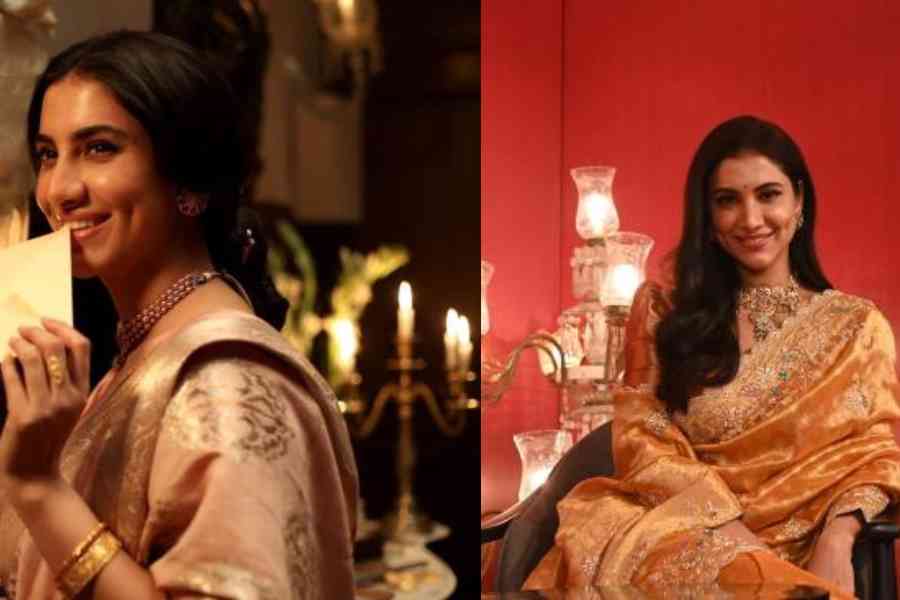Binodini Dasi was a leading stage actress of her time. Against all odds, she carved her path to stardom as Nati Binodini, a name that became synonymous with excellence in Bengali theatre. However, her rise was riddled with societal prejudice and challenges, as the shadow of her past continually threatened to overshadow her achievements. Now, a biopic brings her life story to the screen. Starring Rukmini Maitra in the titular role, Binodini — Ekti Natir Upakhyan focuses on the grit, talent and resilience of the 19th-century woman. Directed by Ram Kamal Mukherjee, the film highlights her struggles and triumphs as she fights for dignity in a male-dominated society. The film explores her journey through the vibrant theatre culture of 19th-century Bengal, enriched by its musical and dramatic heritage. A t2 chat with Rukmini...
What is the genesis of Binodini — Ekti Natir Upakhyan?
When Ram approached me with this film, I was barely two years old in the industry. Everyone knows about Nati Binodini. She was such a big trailblazer; she was a star. When he told me that he was making a film on Binodini, I was very happy for him. When he told me that he was making the film with me, I did not know how to react. I was shocked!
What was your reaction? Did you think, ‘Why me?’
I thought, ‘How me!’
How did he convince you?
He did not have to convince me. Binodini is in our blood. First, he told me that I had to train in Kathak. I had done theatre back in school. We had done Fiddler On The Roof in Nazrul Mancha, and I was the only one who received a standing ovation. I was in Class IX. However, I did not want to be an actor then.
Ram told me that he wanted to celebrate Binodini’s life and bring a canvas that Bengal had never seen before. That is why it took us five years to make this film. Here we have a woman-centric film that has the equivalent budget of a film led by a hero. For five years producers would come and go, commit and exit... nobody knew that I was doing this film. I shot the poster while I was shooting for Switzerland. That time I had two producers from Bombay backing this project. I secretly shot for the Chaitanya poster in 2019. Then the pandemic happened, and everything stopped. The producers went away.
Other producers came in but they were not confident about the budget. They were not confident about a woman being on a poster. They were not okay with a woman playing a titular role. A lot of people from the industry told us to name the film, Girish and Binodini. But Ram said, ‘No, I want to make Binodini.’
Why did you persevere with this film?
Ram convinced me to turn it into my dream. I told him, ‘If Binodini happens, it’ll happen with Ram and Rukmini.’ At the end of 2022, I told Dev about Binodini and showed him the poster. When he saw the poster, his eyes lit up. He bombarded me with numerous questions. I told him that I wanted to do it all on my own. Then he said that he would like to present the film since it is a prestige project.
Why did the story of Binodini connect with you?
Because every part of her, every emotion resonated with me as a woman. Only the years have changed... but we are still fighting the misogyny. I connected with her pain and her pleasure. She was a beautiful mix of pain and pleasure and that is exactly what we are as women. That is what justifies and defines a woman’s life. Binodini was a complete woman. She went through it all, and fought for her independence.
The life of a woman is not city-bound. You step into the interiors of the villages and you’ll see girls are still deprived of the basics. Binodini was one of the biggest feminist icons that we can ever have and she belonged to Bengal. She did not get her due but she is the reason why we are here today. She was an international icon. Imagine, in the late 1800s society was against her since she had portrayed Chaitanya on stage... she battled it all and she performed on stage. She did it all with elan and she guaranteed those houseful shows.
How did you start the research work?
Everything with Binodini and me has been destined to be. Before Binodini happened I was doing acting workshops with Sohini Sengupta for Switzerland and one day she told me about an audiobook of Amar Kotha that she had done. Then she gave me the book, Amar Kotha, and by the time I finished reading Amar Kotha, Ram had called me. This movie is an ode to Binodini; it captures the soul of the person. The challenging part was not only to get into the psychological space of Binodini but also to portray the essential characters that she played.
How did you decide on the scale and the grandeur of the film?
We wanted to depict the sheen on screen while having the soul intact. We are exposed to cinema globally... when we think of a period film in Bengal it looks a certain way. It is made in a certain way. For Binodini..., this was Ram’s vision, and his aesthetics match mine a lot. We knew that the film had to look gorgeous so that people were attracted to every frame. Every frame looks like a painting.
What can the audience expect from the film?
Binodini is not just an emotion. It is not just a tribute. It is a movement. If the film resonates with the audiences, it’ll be another renaissance by Binoidini... for women and women’s place in cinema. This is a story that needs to be told. This is a story that needs to be heard.











